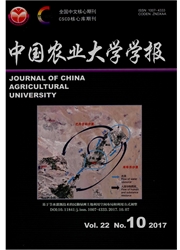

 中文摘要:
中文摘要:
基于HYSPLIT-4模式,利用历史气象数据,研究了小麦条锈病菌的远程传播规律,特别是西北、华北、新疆、四川、云南、贵州之间的菌源关系。结果表明:秋季,西北外来菌源主要来自于四川、云南、贵州,华北外来菌源主要来自于西北、四川、云南、贵州,四川外来菌源主要来自于西北、云南和贵州,云南外来菌源主要来自于贵州,贵州外来菌源主要来自于云南;春季,华北菌源主要影响华北地区,西北菌源主要影响西北、华北、四川的小麦条锈病的流行,四川、云南、贵州的菌源对华北、西北、西南地区有很大影响。其他地区的菌源对新疆几乎没有影响;虽然新疆的菌源偶尔可以传播到其他地区,但是影响很小。
 英文摘要:
英文摘要:
Wheat stripe rust,caused by Puccinia striiformis f.sp.tritici,is the most important wheat disease in China.The epidemics of wheat stripe rust are related to long-distance transports of the pathogen driven by winds.In this study,long-distance transports of the pathogen,especially the interrelationships between the inoculum sources in Northwestern China,Northern China,Xinjiang,Sichuan,Yunnan and Guizhou,were investigated by using HYSPLIT-4 model based on historical meteorological data.Results indicated that in autum the pathogen into Northwestern China is mainly transported from Sichuan,Yunnan and Guizhou,that into Northern China is mainly from Northwestern China,Sichuan,Yunnan and Guizhou,that into Sichuan is mainly from Northwestern China,Yunnan and Guizhou,that into Yunnan is mainly from Guizhou,and that into Guizhou is mainly from Yunnan.Results suggested that in spring the inoculum sources in Northern China mainly cover the wheat production areas in this region.In spring,the sources in Northwest China mainly impact the disease epidemics in Northwestern China,Northern China and Sichuan,and that in Sichuan,Yunnan and Guizhou have great effects on Northern,Northwestern and Southwestern China.The exotic sources hardly influence Xinjiang either in autumn or in spring.The pathogen from Xinjiang could be occasionally transported to other regions with minor impact.
 同期刊论文项目
同期刊论文项目
 同项目期刊论文
同项目期刊论文
 期刊信息
期刊信息
